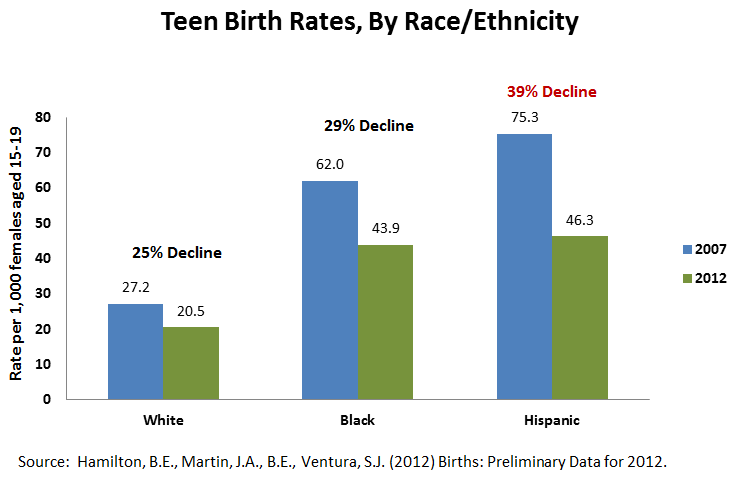After leveling off in the mid-2000’s, teen birth rates dropped by almost one-third between 2007 and 2012, including a six percent decline between 2011 and 2012, according to newly-released data from the Centers for Disease Control and Prevention (CDC). Since 2007, the declines in teen birth rates have been nearly universal, occurring among all age groups of teens and across all 50 states and Washington, D.C. Importantly, these declines have been particularly dramatic among racial and ethnic minority teens, who historically have had higher birth rates than white teens. While that continues to be the case, the gap in teen birth rates has been closing.
Declines in teen birth rates have been especially pronounced for Hispanic teens. For example, in 2007, the Hispanic teen birth rate was almost three times the rate of the white teen birth rate (75.3 compared with 27.2 births per 1000 teens). However, that gap has closed to just over two times the rate in 2012 (46.3 compared with 20.5 births per 1000 teens).
There are several possible reasons behind the accelerated declines in teen birth rates among Hispanics:
- Their declines started later than other racial/ethnic groups.
In the mid-1990s, black teens experienced dramatic declines in teen births, while the decline among Hispanics was much more gradual. From 1990 to 2000, the drop in the birth rate among black teens was almost three times that of Hispanics. The recent dramatic declines among Hispanics have led to similar rates for Hispanic and black teens in 2012.
- The composition of the Hispanic population has changed. An increasing proportion of the Hispanic population is native-born, or born in the U.S. From 2000 to 2011, the number of Hispanics in the U.S. that were native born increased by over 57 percent while foreign-born Hispanics increased by only 33 percent. Because native-born Hispanics have lower teen birth rates than Hispanics born outside the U.S., this change in composition could lead to lower Hispanic birth rates – now and into the future.
- Evidence-based teen pregnancy prevention programs have targeted and been implemented with Hispanic populations. Although fewer than 20 rigorously-evaluated, random assignment teen pregnancy prevention programs have been evaluated with Hispanic populations,1 nine programs have shown promise for delaying or reducing sexual activity and/or for improving condom and contraceptive use among Hispanic teens.2 And included among these nine are programs that are currently being evaluated in federally-funded, national evaluations: ¡Cuídate!, Draw the Line/Respect the Line, and It’s Your Game: Keep it Real.
Despite overall declines in U.S. teen birth rates and particularly impressive declines among racial and ethnic minorities, the U.S. still has the highest teen birth rates in the industrialized world. Teen births continue to have negative social, health, and economic impacts on teen parents, their children, and society, as a whole – and continued high rates of teenage childbearing among racial and ethnic minorities can contribute to intergenerational cycles of poverty. As a result, there is an ongoing need to:
- Replicate evidence-based teen pregnancy prevention programs with a variety of populations (as the Department of Health and Human Services (HHS) is doing with its “Tier 1” Teen Pregnancy Prevention (TPP) and its Personal Responsibility Education Program grantees);
- Rigorously evaluate the effectiveness of new or innovative approaches to reducing teen pregnancy (as HHS is doing with its “Tier 2” TPP Grantees), including programs that focus on low-income and racial and ethnic minority populations; and
- Support the teens who become young parents in their efforts to complete schooling and access health care, child care, family housing, and other critical supports (as HHS is doing with its Pregnancy Assistance Fund grantees).
[] Drawn from Child Trends’ searchable Lifecourse Interventions to Nurture Kids Successfully (LINKS) database, found here: https://www.childtrends.org/what-works/
[] ¡Cuídate!, Draw the Line/Respect the Line, Familias Unidas, Families Talking Together, It’s Your Game: Keep it Real, Positive Prevention, Project Respect, Sisters Saving Sisters, Teen Talk
© Copyright 2025 ChildTrendsPrivacy Statement
Newsletter SignupLinkedInYouTubeBlueskyInstagram


